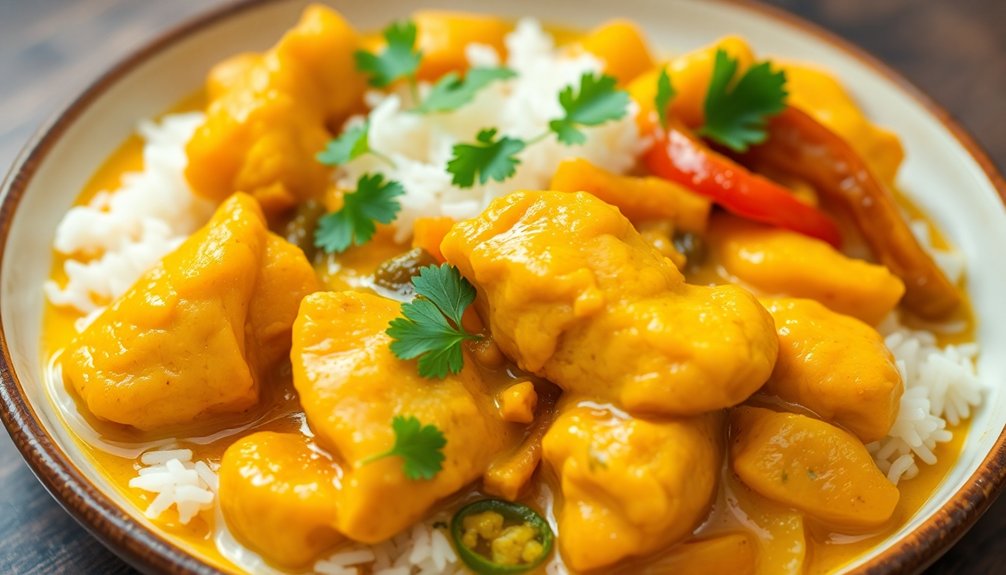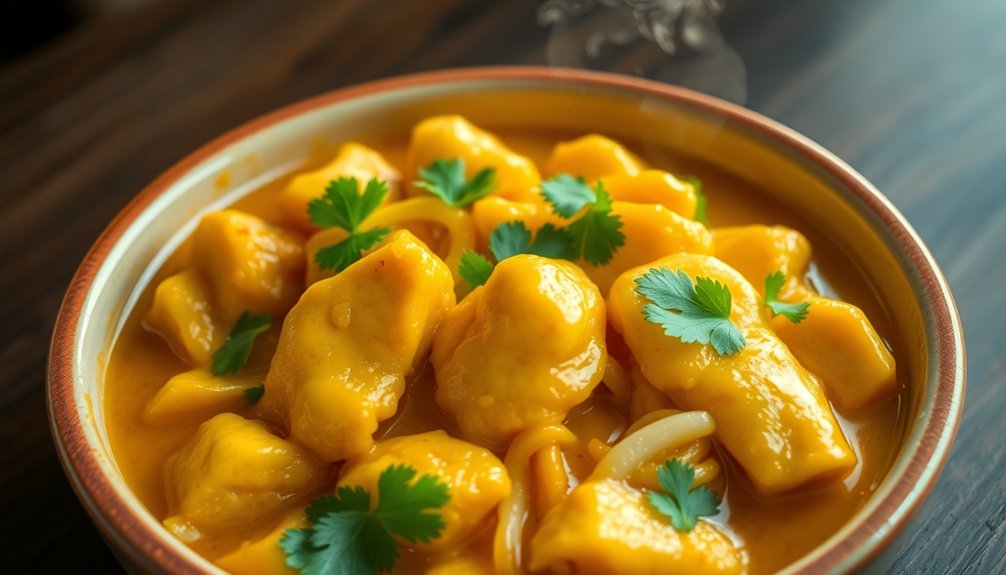Gai Pad Pongali - Yellow Curry Stir-Fried Chicken
You'll discover a harmonious blend of Thai and Chinese influences in Gai Pad Pongali, where tender chicken meets aromatic yellow curry in a wok-fired masterpiece. This beloved comfort dish combines curry paste, coconut milk, and eggs with perfectly seared chicken, creating a rich, creamy sauce that's customizable to your heat preference. Master the key techniques of timing and temperature control, and you'll reveal the secrets of this flavorful Thai classic.
Key Takeaways
- Gai Pad Pongali is a Thai dish combining yellow curry and stir-fried chicken, influenced by Indian curry flavors and Chinese cooking methods.
- The dish requires chicken breast, yellow curry paste, eggs, onion, garlic, mixed vegetables, and coconut milk as primary ingredients.
- Cooking involves stir-frying marinated chicken, blooming curry paste, and gradually adding rice and broth to achieve proper consistency.
- The final dish is garnished with spring onions and Thai basil, typically served hot with steamed rice.
- Spice levels can be adjusted by modifying curry paste amounts, and the dish pairs well with cucumber salad or som tam.
History

While the exact origins of Gai Pad Pongali remain debated among Thai culinary historians, this aromatic yellow curry stir-fry emerged from Thailand's southern coastal regions in the early 20th century.
You'll find that this dish represents a fascinating culinary evolution, blending Indian curry influences with traditional Thai cuisine's bold flavors and techniques.
As Chinese immigrants settled in Thailand's port cities, they introduced wok cooking methods that transformed how locals prepared curry dishes.
The regional variations you'll encounter today reflect this cultural significance, with some versions incorporating coconut milk while others stay true to the drier stir-fry style.
In Bangkok, you'll notice restaurants often serve a creamier adaptation, while southern provinces maintain a spicier, more concentrated curry flavor profile.
Recipe

Ingredients:
- 300g chicken breast, sliced
- 2 tbsp yellow curry paste
- 2 tbsp vegetable oil
- 2 eggs, beaten
- 1 onion, sliced
- 2 cloves garlic, minced
- 1 cup mixed vegetables (carrots, bell peppers, green beans)
- 2 tbsp fish sauce
- 1 tbsp oyster sauce
- 1 tsp sugar
- 1/2 cup coconut milk
- Spring onions for garnish
Instructions:
- Heat oil in a wok over medium-high heat.
- Add garlic and yellow curry paste, stir-fry until fragrant (30 seconds).
- Add chicken and cook until nearly done (3-4 minutes).
- Push ingredients to one side, add beaten eggs and scramble.
- Add onions and mixed vegetables, stir-fry for 2 minutes.
- Pour in coconut milk, fish sauce, oyster sauce, and sugar.
- Cook until sauce thickens and vegetables are tender (2-3 minutes).
- Taste and adjust seasoning if needed.
- Garnish with spring onions.
- Serve hot with steamed rice.
Cooking Steps

Start by heating vegetable oil in a wok over high heat until it's shimmering.
Then add your chicken pieces and sliced onions to stir-fry until golden brown.
Next, you'll incorporate the yellow curry paste and aromatic spices, allowing them to bloom in the oil before adding your day-old rice and chicken broth, stirring constantly to coat each grain with the vibrant curry sauce.
Finally, toss in fresh Thai basil leaves right before serving, letting their anise-like fragrance perfume the entire dish.
Step 1. Heat Oil in Wok
Pour 2-3 tablespoons of vegetable oil into a hot wok over medium-high heat.
You'll want the wok hot enough that a drop of water sizzles and evaporates instantly when it hits the surface. While vegetable oil is traditional, you can also use peanut or canola oil for their high smoke points and neutral flavors.
Tilt and swirl the wok to guarantee the oil coats the cooking surface evenly, creating a natural non-stick barrier.
Watch for the oil to ripple and shimmer - this visual cue indicates it's reached the ideal temperature for stir-frying. If you notice the oil starting to smoke, quickly reduce the heat.
The goal is to maintain a consistent wok temperature that's hot enough to sear but not so hot that it burns the aromatics you'll add next.
Step 2. Add Chicken and Onions
Slide the marinated chicken pieces into the shimmering oil, spreading them out in a single layer to maximize contact with the wok's hot surface.
Let the chicken sear undisturbed for 1-2 minutes until the edges start to turn golden brown. The chicken marinade will create a flavorful crust as it caramelizes.
Add your sliced onions to the wok, stirring them in with the partially cooked chicken.
You'll want the onion texture to remain slightly crisp, not mushy. Keep the ingredients moving constantly now, using your spatula to toss and flip everything together.
The onions will release their natural sweetness as they cook, complementing the savory notes of the curry-marinated chicken.
Continue stir-frying until the chicken is just cooked through and the onions are translucent with a slight crunch.
Step 3. Add Curry Paste and Spices
Tossing the fragrant yellow curry paste into the hot wok, create a small well in the center of your chicken and onion mixture. Let the curry paste sizzle for 30 seconds until it releases its aromatic oils. Stir the paste into the ingredients, ensuring even distribution for balanced curry flavor throughout the dish.
Now sprinkle in the turmeric, white pepper, and a pinch of salt. Work quickly to incorporate these spices before they burn, maintaining the ideal spice balance.
Add a splash of coconut milk to help the curry paste coat each piece of chicken uniformly. Keep stirring continuously as the sauce thickens and clings to the meat, allowing the flavors to intensify and meld together over medium-high heat for about 2 minutes.
Step 4. Add Rice and Broth
With the curry base now richly developed, introduce the day-old jasmine rice by crumbling it into the wok with your spatula.
While jasmine rice is traditional, you'll also achieve good results with long-grain or basmati varieties - just guarantee it's properly dried and chilled beforehand.
Pour in your chosen broth - chicken stock works best, though vegetable stock can substitute.
You'll need just enough liquid to coat the rice without making it soggy. If you're using homemade bone broth, you'll get extra richness and body.
Add it gradually, about 1/4 cup at a time, allowing the rice to absorb each addition before adding more.
Keep stirring constantly to prevent the grains from clumping and to guarantee they're evenly coated with the curry sauce.
Step 5. Garnish With Fresh Basil
Fresh Thai basil leaves bring the essential aromatic finish to your Gai Pad Pongali. Take a handful of basil leaves, remove them from their stems, and scatter them generously over the hot dish just before serving. The heat will gently wilt the leaves, releasing their distinctive anise-like fragrance and enhancing the curry's complexity.
For maximum basil benefits, choose leaves that are vibrant green and free from blemishes.
Advanced garnish techniques include chiffonading the basil into thin ribbons or creating a basil crown by arranging whole leaves in a circular pattern. You'll find that Thai basil's robust flavor profile complements the yellow curry paste while adding a fresh, peppery bite that cuts through the dish's richness.
Don't substitute sweet Italian basil, as it lacks the intensity needed for authentic Thai cuisine.
Cooking Tips

To achieve the perfect balance of flavors in Gai Pad Pongali, you'll need to monitor the curry paste carefully as it cooks in the hot oil.
The cooking techniques for this Thai dish require precise timing and temperature control to develop the curry's complex flavors. If you can't find certain ingredients, there are several ingredient substitutions that'll work well.
- When frying the curry paste, look for tiny bubbles forming around the edges - that's when you know it's releasing its aromatic oils.
- Don't overcrowd the pan when adding chicken; cook in batches if needed for proper browning.
- If the sauce becomes too thick, add coconut milk gradually while stirring constantly.
- Keep your wok or pan hot throughout cooking, but reduce heat if the curry paste starts to burn.
Final Thoughts

Once you've mastered Gai Pad Pongali's fundamental techniques, you'll discover why this aromatic yellow curry stir-fry has become a beloved Thai comfort dish.
Its distinct flavor profile balances the warmth of curry powder with the sweetness of onions and the richness of eggs, creating a harmonious blend that's uniquely Thai-Chinese in character.
For serving suggestions, pair your Gai Pad Pongali with jasmine rice to soak up the fragrant sauce. You can also serve it alongside a fresh cucumber salad or som tam for textural contrast.
Don't hesitate to adjust the spice levels to your preference - that's the beauty of cooking this dish at home.
Frequently Asked Questions
Can I Substitute Chicken With Other Meats in Gai Pad Pongali?
You can swap in beef alternatives like sliced flank steak or seafood options such as shrimp, ensuring you adjust cooking times and maintain the same fragrant yellow curry seasonings.
How Spicy Is Gai Pad Pongali Compared to Other Thai Dishes?
You'll find it's milder than many Thai dishes, with moderate spice levels that won't overwhelm you. The yellow curry's flavor profile emphasizes warmth and aromatics over intense heat.
What's the Best Type of Rice to Serve With This Dish?
You'll want fragrant Thai Jasmine rice as your first choice - it perfectly soaks up the curry sauce. For a richer experience, try Coconut Sticky rice's sweet, creamy texture.
How Long Can Leftover Gai Pad Pongali Be Stored in the Refrigerator?
Like a vibrant curry losing its sheen, you'll need to prioritize food safety with your leftovers. Store them properly in an airtight container and consume within 3-4 days for best quality.
Is Gai Pad Pongali Gluten-Free by Default?
While traditional ingredients like curry paste, coconut milk, and chicken are gluten-free, you'll need to check your soy sauce and watch for cross-contamination risks in shared cooking spaces.
